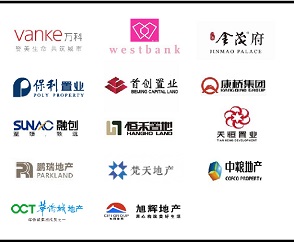庄子玉: 安徽铜陵山居改造空间设计
我们此次项目的业主吴彦祖说:“子玉你看村里这颗最高的残树是最美的,咱们以后的房子里应该能够看到它”。于是我们将残墙一分为二;中段化为庭院,夜观星河,四水归堂;檐口化为两分异质脊线,与山峦并行;而那颗高耸的残树和古老的村落,则被引入我们的铜陵山居。
The owner of this project Daniel Wu said, “Ziyu, look at this tallest tree survived in our village. It is beautiful. It should be seen in our house after rebuilt.” So we divided this residual wall into two parts; the middle part was used as a courtyard where we can admire the stars at night and the water from four directions can flow into it. The eaves divided the two ridges in different materials parallel to the mountains. The towering surviving tree and old village were included into our Tongling Recluse.
——庄子玉《山居实录》Ziyu Zhuang, Memoir of Mountain Household

▲白天全村景色 the village in daytime ©苏圣亮

▲俯瞰 aerial view ©许挺
传统性与当代性在现今中国的建筑实践中永远都处于一种交织中的并行状态。就像铜陵山居这个项目,起始于一幢徽州与沿江风格融合的普通民居,地处皖南一个僻静山村。原有建筑处于全村最高的山顶,占地较小,且现状及为残破,已逾十年未有人居住,故其四周皆为杂草和灌木覆盖;其东西向三跨,南北向一跨,原有屋面和墙体损毁严重。
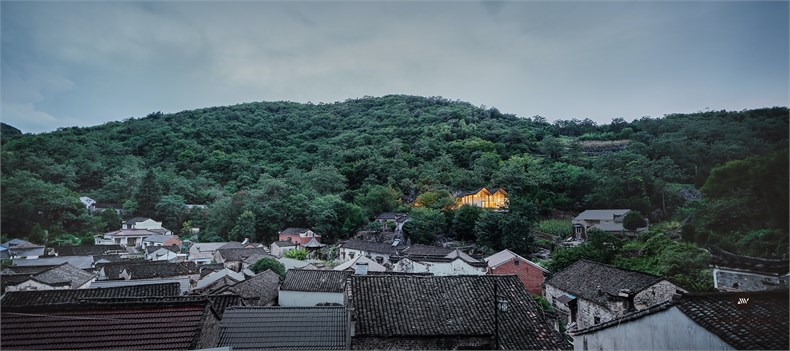

▲建筑所在地 the site of the development ©苏圣亮
In today's architectural practice in China, tradition and modernity are interwoven and coexist together, just like this Tongling Recluse. It is located in a remote village in the north of Anhui Province originally a normal folk house in the style of Huizhou and Yanjiang. Nested on the top of the mountain, this small house was in an extremely bad condition covered by weeds and bushes and uninhabited for over ten years; It has three bays in east-west direction and one bay in south-north direction. Its original roofing and wall were badly damaged.
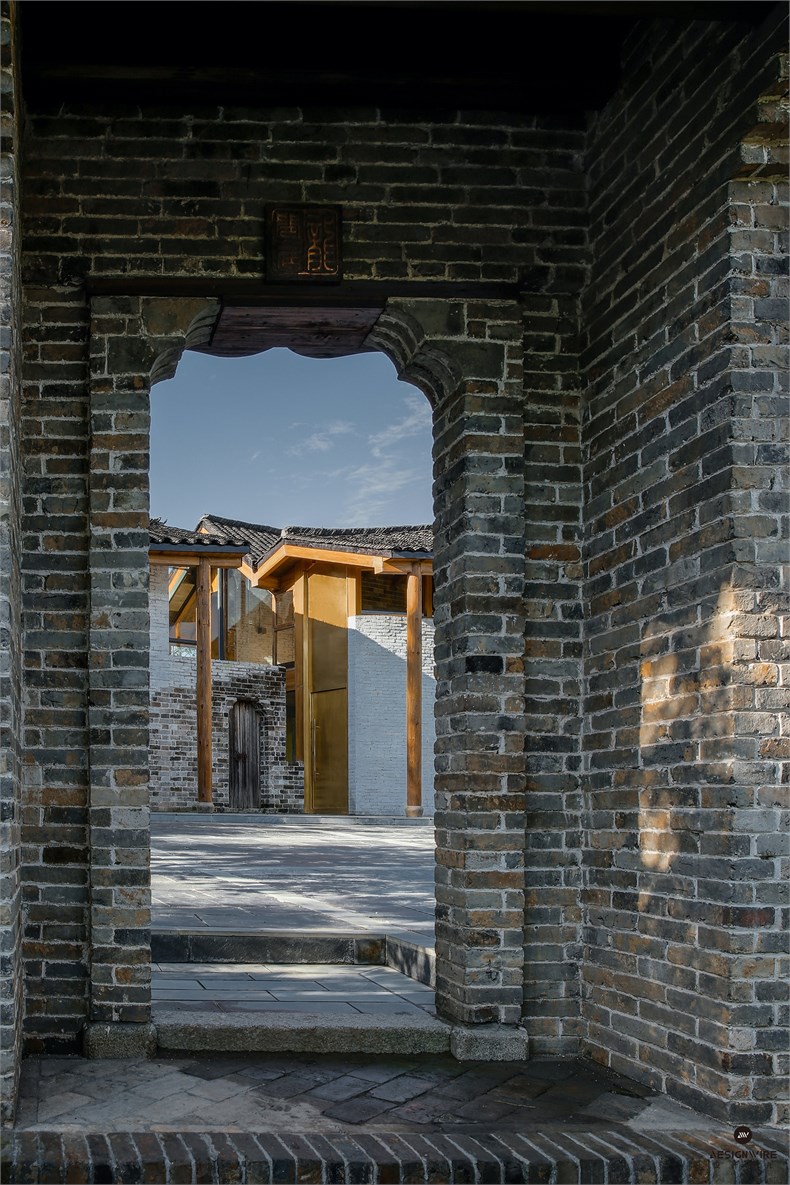
▲院门 gate ©苏圣亮
故而从平面布局上我们考虑西向增加一跨直抵一侧岩石山体,南北向部分增加一跨以形成较宽阔的起居室空间;并在平面上部分引入曲线,一个异化的虚体从原有投影轮廓中抽离出来;由于原有层高的限制和原有屋面完全破损不能再用,我们选择将原有建筑加高至两层,并结合平面上抽离出的双生虚形在空间上放样拉伸,并将前面的部分脊线压低,形成前后错落的空间连续曲面。传统的折面屋面和旁边抽离出来的流线型融合成一体,并暗合了中国文化道生一一生二的宇宙观;整个屋面以青瓦覆盖,在鸟瞰角度形成独特的形态,与现有的古村落,既融合又出挑,并将室内空间的特征从外部进行首次表述。
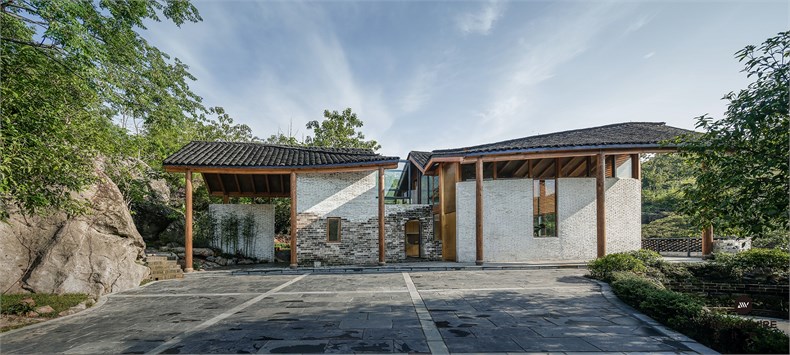
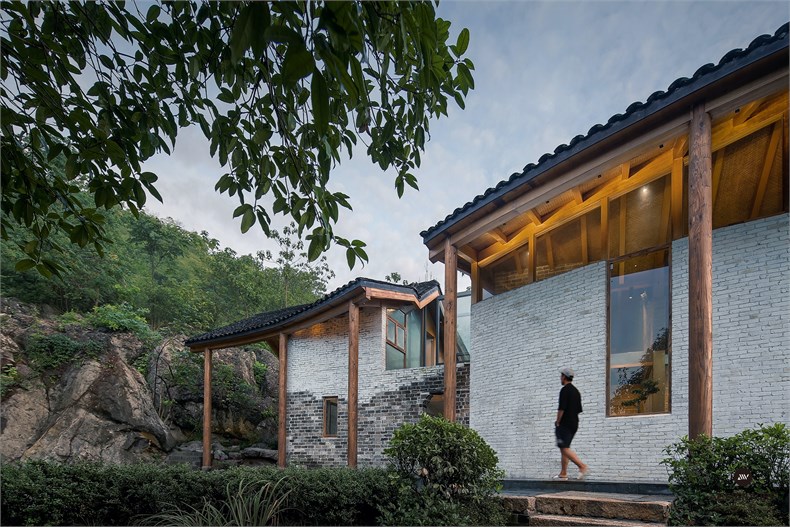
▲建筑正立面 the front elevation view ©苏圣亮
Starting from the plan layout, we considered adding one bay to the west to reach the rocky mountain on one side, and another bay in the south-north direction to form a wider living space; We used sweeping curvature that rises to create an imaginary space detached from the original projection. Because of the limitation of original height before and badly damaged roof, we added new floors to the original building up to two. Together with the imaginary space detached from the original projection, we create an open spatial view. We lowered part of ridge in the front to form an uneven continuous curved silhouette. Traditional folded roof and the detached streamlined space were blended together and coincided with the cosmology of Chinese culture - “The Dao (Way) produces One (world), One produces Two (Yin-Yang)....”; the whole roof was covered by grey tiles in an unique shape from a bird’s eye view, which was not only outstanding but also a convergence of existing ancient village. This was the first time to echo the features of indoor space in outdoor areas.
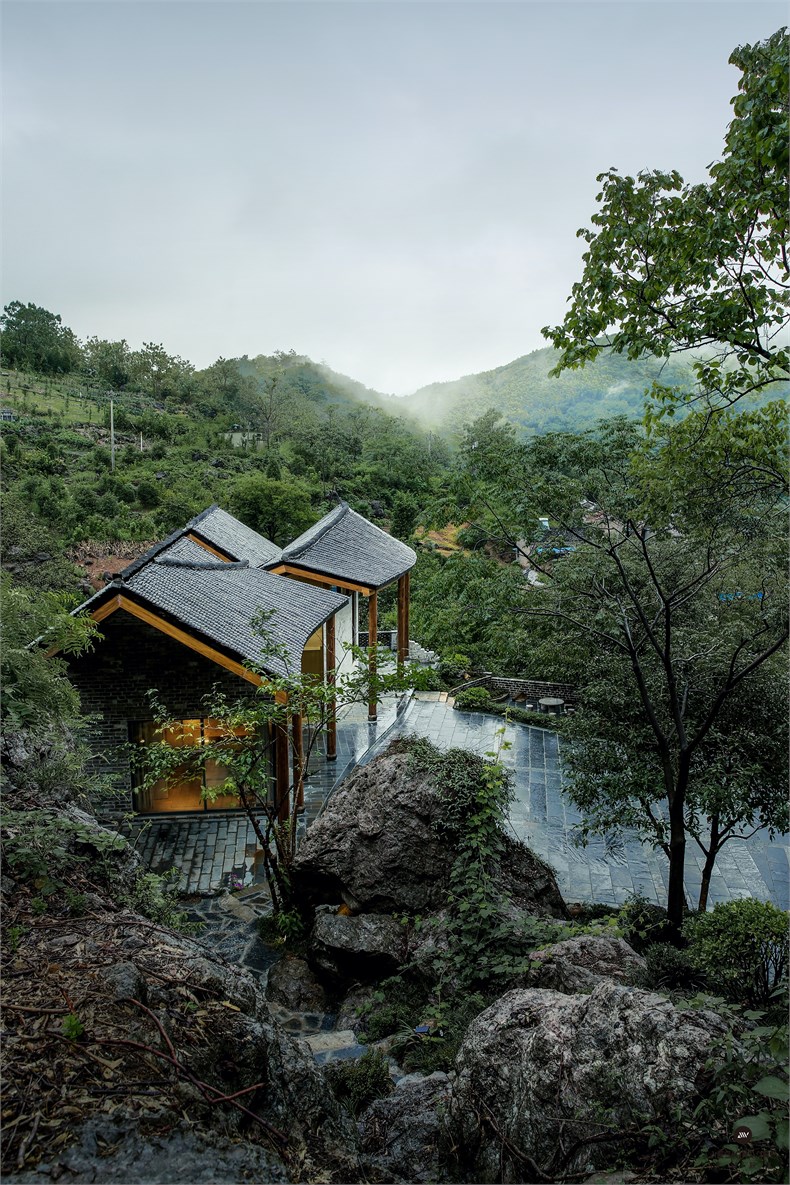
▲山坡半鸟瞰 aerial view from the hillside ©苏圣亮
如此形成的东西向的四跨空间,从东起,一跨形成地块南向的作为起居室的前厅空间,一跨与横向展开的部分残墙形成的庭院空间及其二层的玻璃观景平台,一跨与西侧的原建筑墙体形成的卧室空间,增加一跨向西将山体和营造的部分景观空间纳入其半开放的檐下虚空间;由此在南立面上构成一幅传统语境下的当代拼接画。
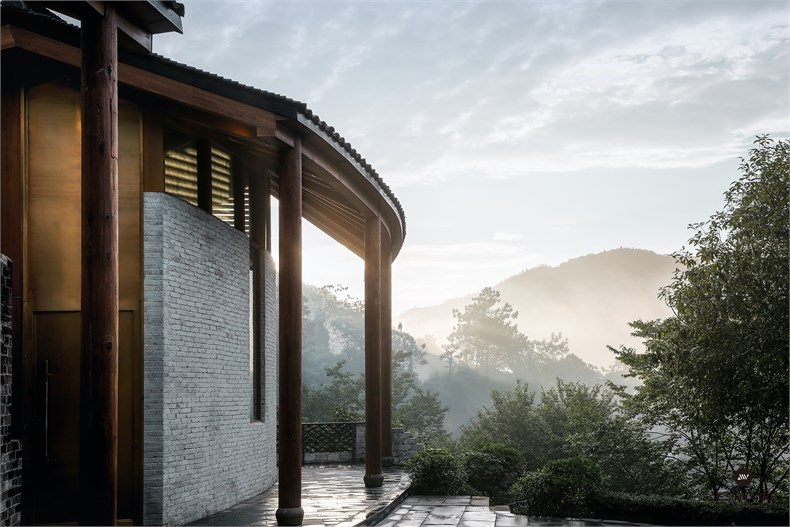

▲铜门 bronze doorway ©苏圣亮
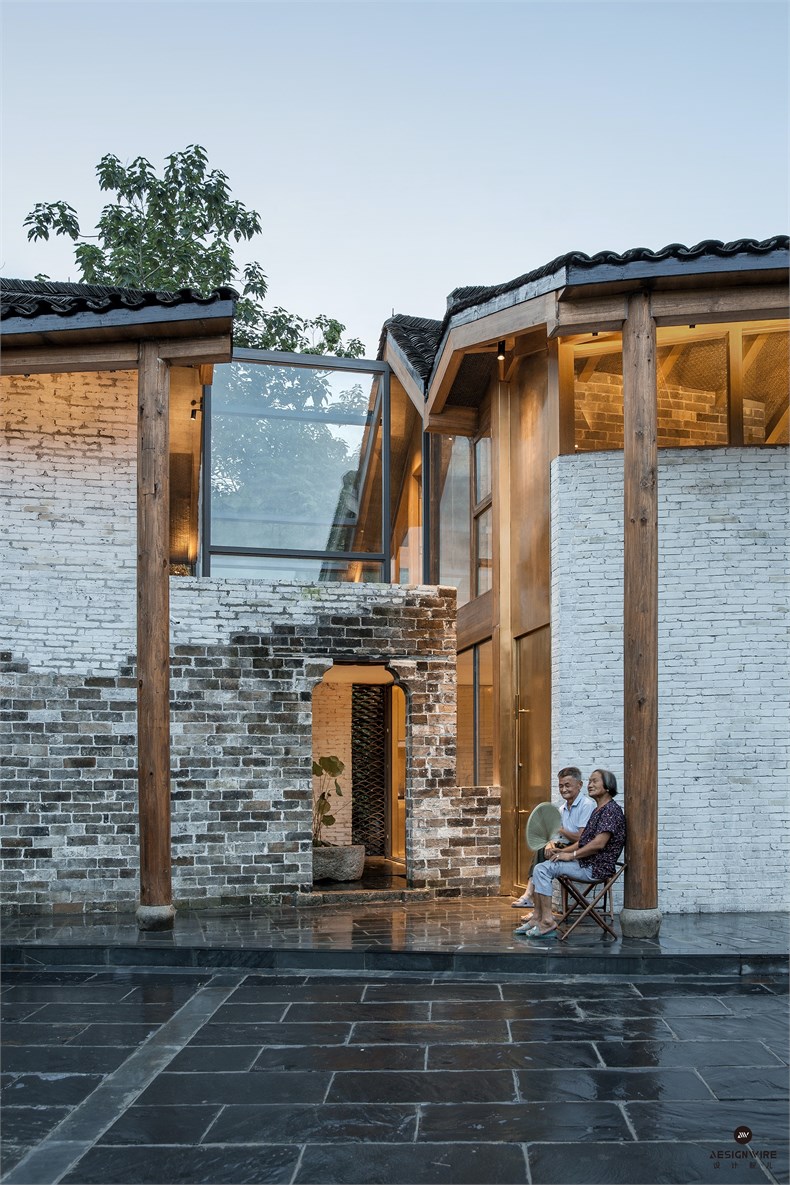
▲入口 entrance ©苏圣亮
The four bays formed a space in east-west direction. From the east, one bay to the south was used as the front hall next to the living room. One bay transversing part if the residual wall was a courtyard connecting the glass platform in the second floor. One bay with the original wall in the west formed a space for the bedroom; The added floor to the west covered the mountain view and part of the built landscape into its semi-open virtual space under the eaves. Elevation view looking south this is picture of modern house under traditional context.
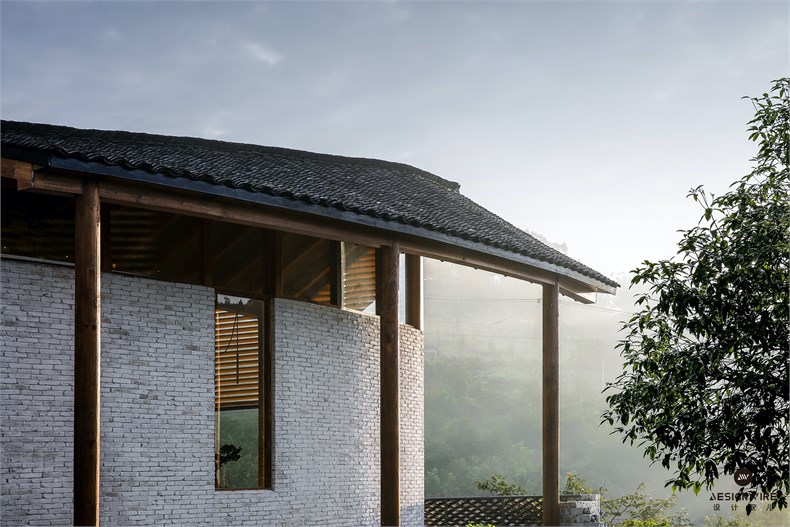
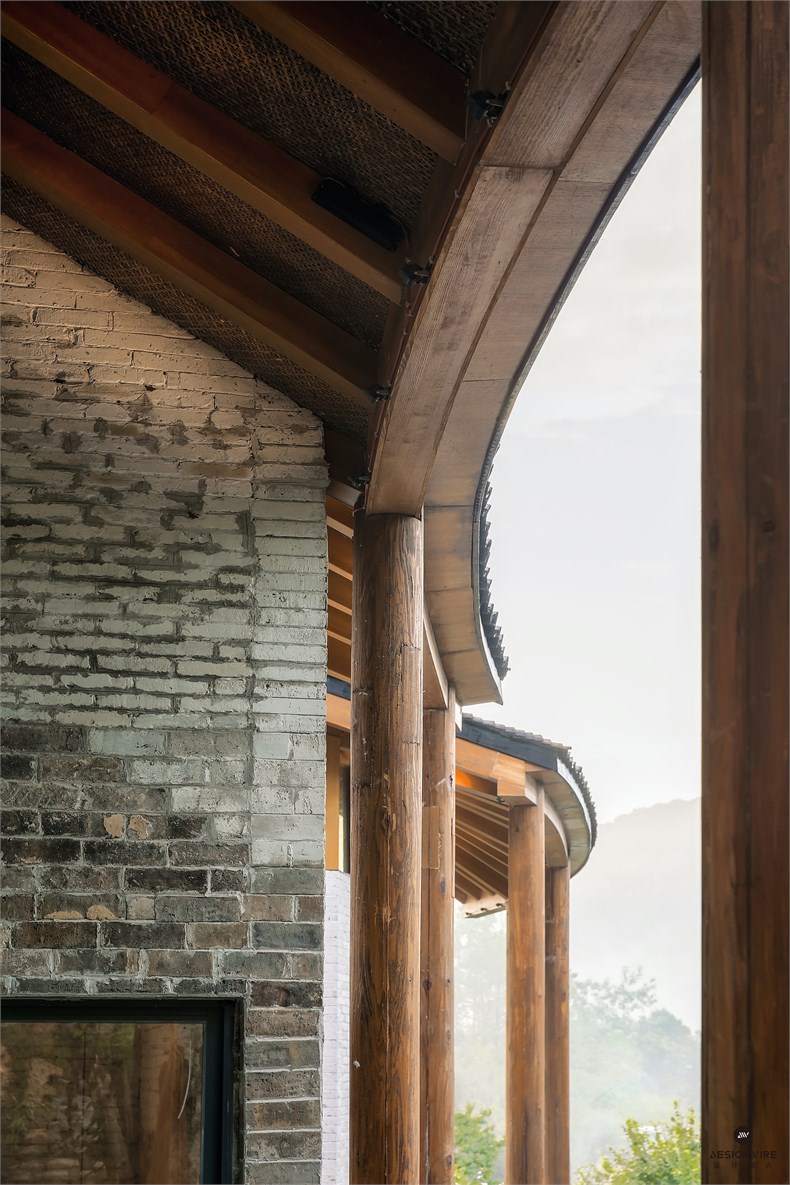
▲木制屋檐 wooden eave ©苏圣亮
故其东侧立面在原有建筑的单脊面一侧又新生一脊,进一步暗示了这种双生关系的线索,并形成一种宁静的平衡。新脊自成一跨,其中一半并入原建筑外轮廓,另一半形成檐下外廊,形成东立面上的虚实对比,并与南侧的下沉庭院景观形成对话。与南立面的横向展开的散点透视关系不同,东向悬崖方向的姿态更加倾向于一种单点透视的主体画面感,从中透射出的室内的铜饰构件及出挑的露台和挑檐,昭示着一种活力和期待感。
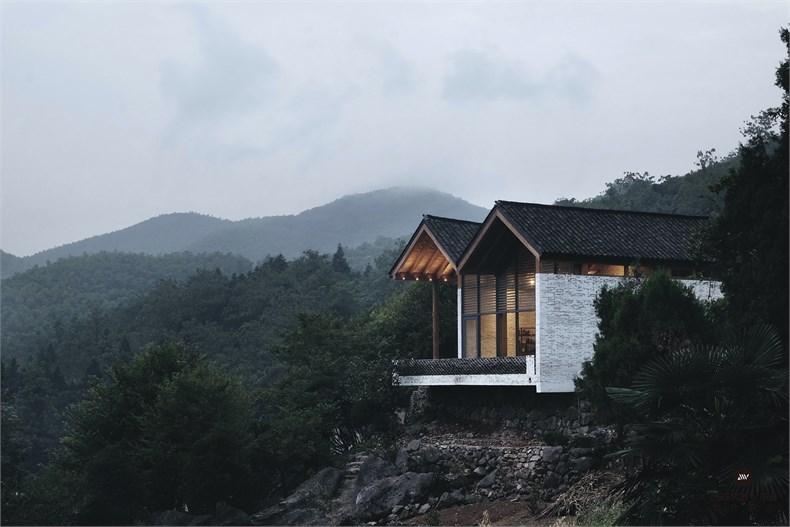
▲看台 bleacher ©梵几
East elevation generated a new ridge on the side of single ridged original building, manifesting the twin relationship and forming a kind of peaceful balance. The new ridge formed a bay of its own. One half of it incorporated into the outdoor contour of original building and another half formed the veranda under the eave. The design shows the virtual space against physical house in east elevation and converses with sunken garden landscape in the south. Different from the scattered view in the south, the high altitude cliff to the east projected a single-body view. It foretells the vitality and expectation of the copper fixtures inside the house and the spotlighting terrace and eaves.
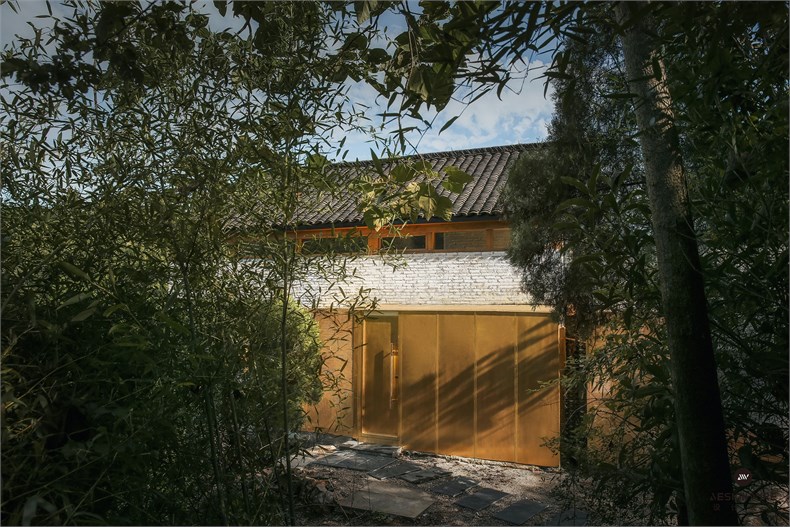
▲背立面 back elevation view ©苏圣亮
与外部廊道空间并置的,即为建筑的主要内部活动空间,由上述一系列新老墙体交错而成,故而原残损的墙体在建筑室内变成了数段内部墙体和室内隔断。从东向西,露台,起居室,餐厅,厨房,庭院,卧室由其私密性的逐级递减向西一字排开。居者通过外部廊道空间从室外台阶由南进入起居室,在此开展家庭聚会和活动;首层局部挑空,以获得更好的公共性和视野;从此向右到达半室外的露台部分远眺群山或俯瞰整个村落;从此向左转到达更私密的餐饮空间和与之对应的厨房部分。建筑首层设有一间卧室及洗手间,从起居室的楼梯空间上去是阁楼上的两间卧室和洗手间。
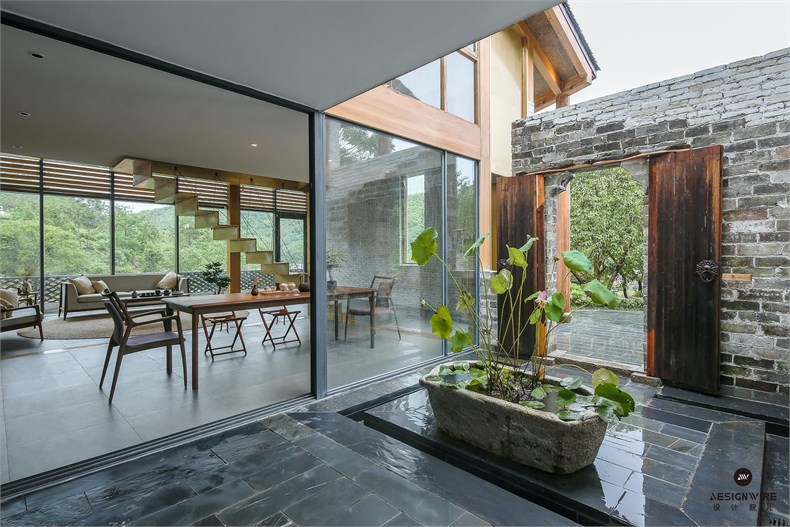
▲内庭院 internal courtyard ©苏圣亮
The main indoor space mixed with the external veranda shaped by the interlaced new and old walls. The original damaged walls in the building became sections of interior walls and indoor partition. From the east to the west, terrace, living room, dining room, kitchen, courtyard and bedroom lined up according to their privacy. Through the veranda and steps outside, resident can come from the south into the living room to hold family parties or activities here. Part of the first floor was empty space for better view; Coming to the right to the semi-open terrace, resident can overlook the mountains and the whole village; From here turning left, resident can reach the dining room with better privacy and the kitchen opposite to it. On the first floor were a bedroom and rest room. Going upstairs from the living room, there were two bedrooms and rest rooms.
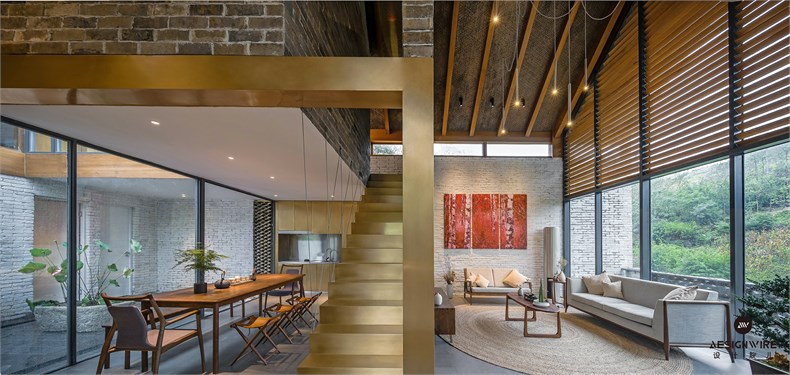
▲餐厅、客厅 dining room and living room separated by bronze-made staircase ©苏圣亮
中庭空间作为整个平面布局的核心部分,完成了由原建筑室内空间变成新建筑的室外空间的属性转换。其南侧的原有墙体和老门都得以保留,彰显对原有记忆的尊重和致敬;作为对比和呼应,我们在老门的一侧我们设置了一扇高5米宽1.2米的铜制新门,通过极大的比例差异增强仪式感(这种做法在欧洲的许多当代教堂空间设计中屡见不鲜);同时作为对于铜都文脉的回应,同时从此铜门进入室内,有一铜框形成的餐厅空间与之相接,并在一侧植入了一部铜折板的楼梯通向二楼空间;此铜框同时承载了原有建筑的东侧山墙,在此部分的原有山墙成为了起居室空间的装饰墙和垂直交通部分与居室空间的视线遮蔽。铜框的北侧整合了一套铜制整体厨房以及北侧后门,可拾级而下联通山下的菜地。整体厨房是嵌入墙体并突出与北侧山墙的,我们同时将建筑所有的空调室外机罩部分与这个突出山墙的铜制体块相整合。故而从整体布局和鸟瞰上能够感受到整个建筑由铜入由铜出的空间联系和材质的连续感。建筑其他部分和主体结构则皆为木质表达,再现了些许原址上的生活状态和文脉特质。
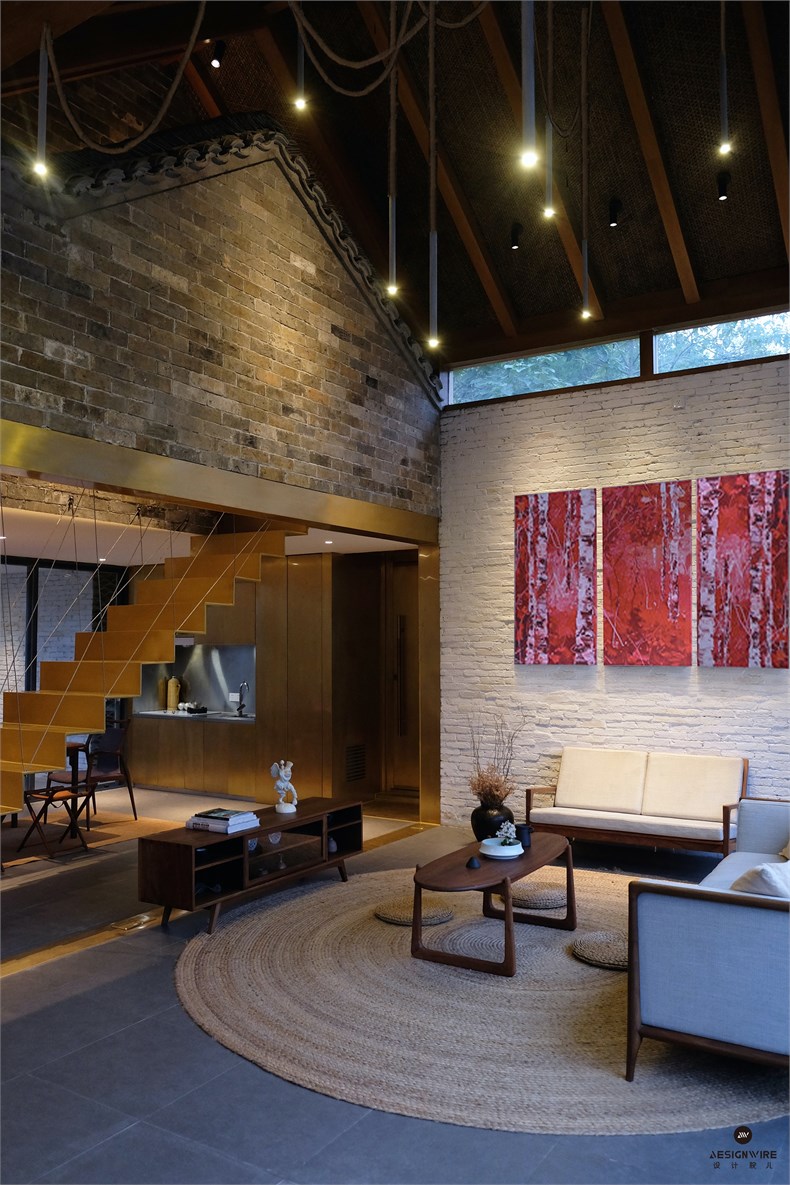
▲客厅 living room ©梵几
As the core of the whole plan layout, the atrium changed from the original indoor space to the new outdoor space. The original wall and old door in the south were kept to show the respect to the original memory. As a contrast and echo, we set a brass-made new door with the height of 1.5 meter and the width of 1.2 meter on one side of old door to strengthen the ceremonial feeling by huge difference in proportion (such practice is common in the spatial design of many modern churches in Europe). As an echo to the context of copper capital, coming into the room through this copper door, there is a copper-framed dining hall connected with it. We have installed a copper-plated staircase to reach the second floor. This copper flame also carried the original gable in the east. The original gable here became the decorative wall to block the vertical view of the living room and bedrooms. In the north of copper frame, there was a kitchen equipped with a full set of copper apparatus and the backdoor in the north, where we can go downstairs to the vegetable field under the mountain. The whole kitchen was inset to the wall and protruded out of the northern gable. We combine all the outdoor air conditioners and the copper frame/kitchen protruded out of the gable. From a bird's eye view, we can feel the spatial linkage of the copper sections of whole building and the continuity of materials in layout design. Main structure and other sections of the building were wooden material, which reproduced the living conditions and cultural context of the original building.

▲二层走廊 corridor on F2 ©苏圣亮
整个中庭空间与西侧的檐下景观虚空间形成了东西一线的虚实关系的反复转换,同时配合悬浮的飘板楼梯,东侧的落地玻璃,形成传统民居空间不曾达到的居室空间的通透性。南北向则通过一系列线性高窗将双曲线屋面与墙体相分离,强化屋面的漂浮感和当代性。同时通过一系列小窗与楼梯主卧等重要建筑构件形成视线的呼应和室内外的对景关系。

▲二层休息厅 lounge on F2 ©苏圣亮
The whole atrium and the landscape under the eave formed the repeating virtual-physical transformation in the east-west direction. At the same time, the suspended stairs and French window in the east formed an open space connecting the bedrooms which cannot be found in traditional folk residences. An array of high windows lined up in the north-south direction separated the two sloping roofs from the walls. The design was to strengthen the floating and modernity of roof. Another array of small windows together with important fixtures including stairs and master bedroom formed the line of sight that echoes the contrast between indoor and outdoor space.
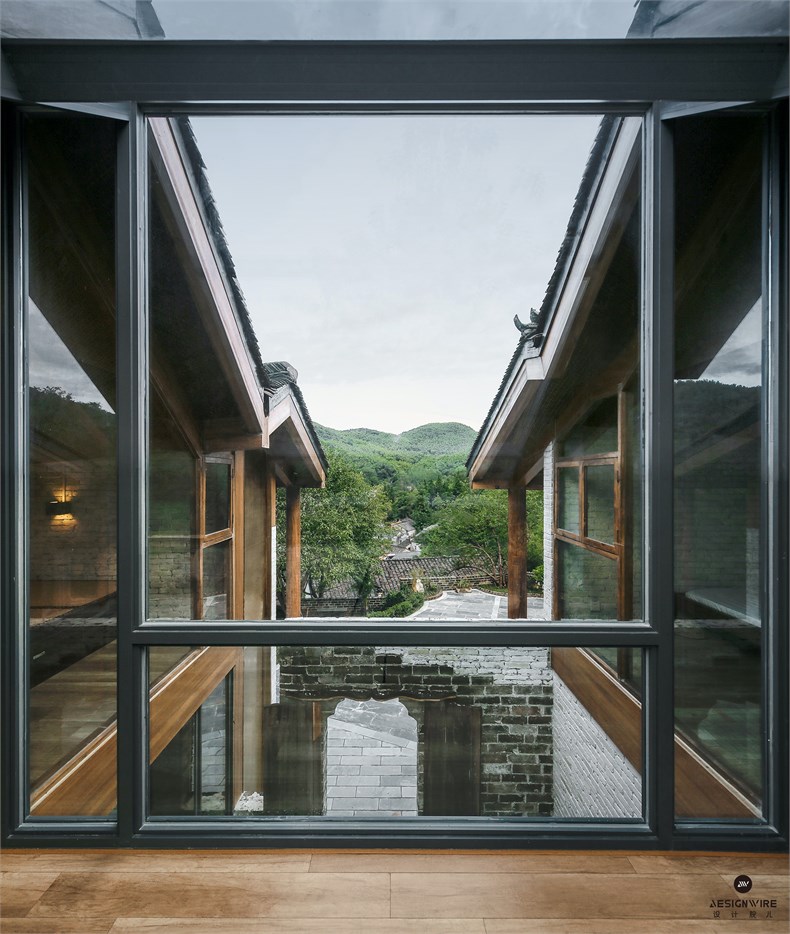
▲二层山色 mountain sight by standing on F2 ©苏圣亮
建筑南侧是由入口空间展开的部分室外景观,软性的景观元素旨在和建筑共同打造曲径通幽的视觉通廊,并结合建筑的曲线屋面,将远处山峦引入建筑空间框定的画境之中。西南侧为一山门,从山下拾级而上,山门与建筑的中断形态形成第一个框景,并与南侧矮墙北侧建筑一同形成了一个围合的庭院;建筑西侧檐下空间和喀斯特地貌岩石山体形成一个环形的石阶游廊,从山门入口处起,从檐下庭院处止;东南侧结合原有的一个高大乔木设置了下沉庭院,对其领域感加以限定,并置入石桌石凳,形成建筑室外的休憩场所。东侧为落差不大的悬崖,建筑由此出挑2米;居者从建筑北侧后门出来,由自然化的台阶和植被引导,可达户外台地和作物种植区域,体验远离尘世的乡野趣味和田园画境。
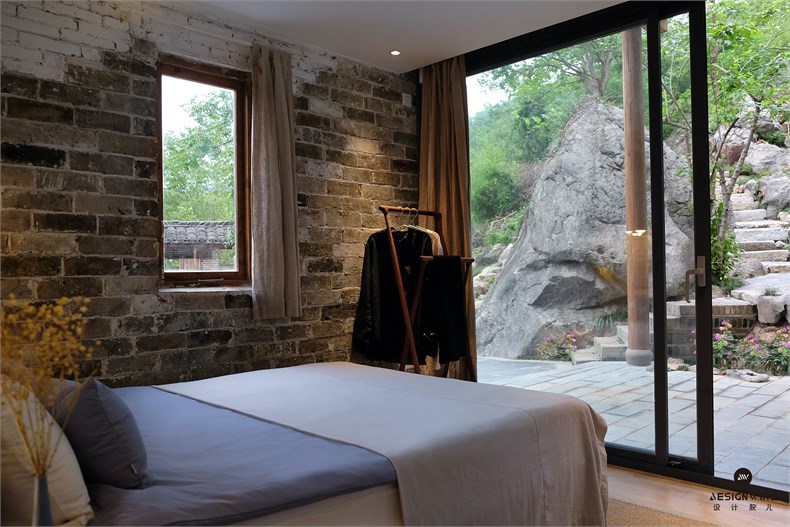
▲主卧 master bedroom ©梵几
Part of the outdoor landscape can be viewed at entrance in the south of the building. Soft landscape element was aimed at creating the visual gallery with the buildings. Combining with the curved roof, remote mountains became part of the picturesque scene. A gate lies in the southwest. Walking up the mountains, the view of the building interrupted by the gate formed the first scenery. The gate also formed an enclosed courtyard together with the building in the north , and short walls in the south; The space under the eave to the west of buildings and karst rocky mountain formed an annular stone steps veranda, starting from the entrance of gate to the courtyard under the eave; In the southeast, there was a sunken courtyard t combining the original tall arbor tree to emphasize the limited space, which was used as an outdoor resting place with stone table and stone chair. Because of the cliff on the east side was not steep, decoration element of the building protruded s up to 2 meters. Led by the natural steps and plants, resident can go to the outdoor terrace and green area through the backdoor on the north side of the building, away from the worldly cares and enjoy the countryside and rural picturesque .
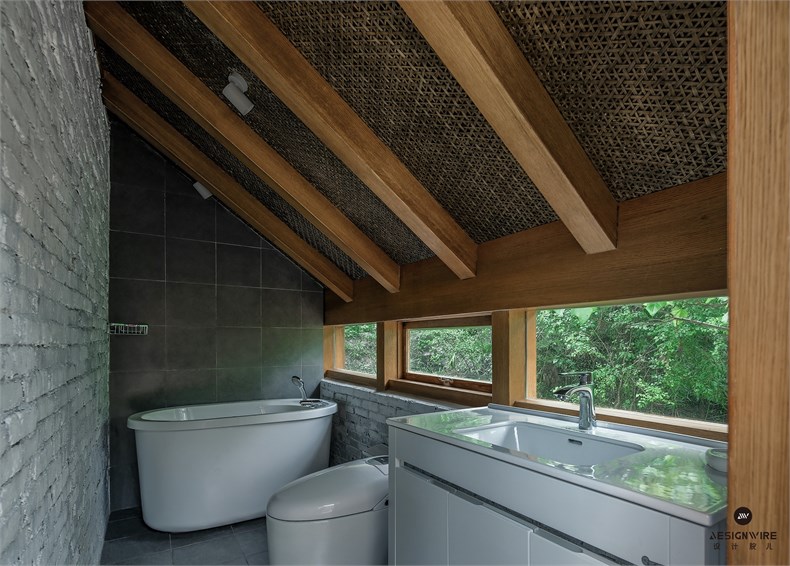
▲二层卫生间 bathroom on F2 ©苏圣亮
在场地条件受限的情况下,为了快速实现异化的三维曲线屋面形式,同时弱化结构构架尺寸对于需要保留的传统建筑元素和构件的影响,整个建筑采用了现场加工钢结构的建造方式,并由一条架设于场地和临近道路的悬空栈桥作为施工材料的运输通道。
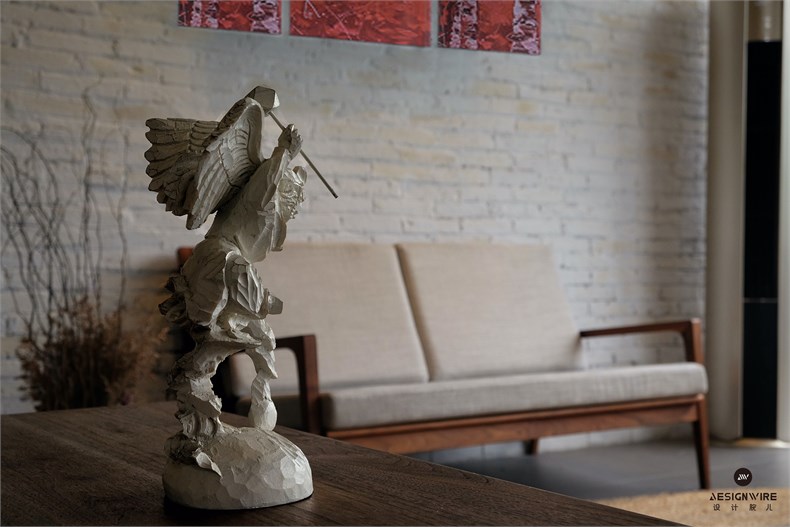
▲陈设 local hand-craft decoration ©梵几
Under the limitation of site condition, in order to quickly realize three-dimensional curvature for the roof and weaken the impact of the size of structural frame to retain essential traditional architectural element and component, we used steel frame and rebuilt the whole building at the site. A suspended trestle was mounted connecting the site to adjacent road for the transport of construction materials.
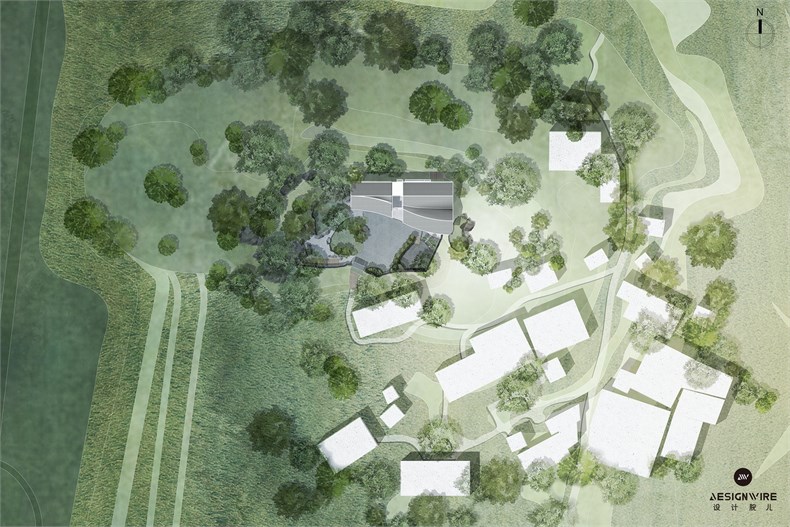
▲总平面图 master plan
为在有限的技术条件下实现双生曲面屋顶的建造,我们提取出平行于山墙面的方向的若干“切片”式折线以及沿屋脊方向的几条结构曲线,形成整个屋面的钢结构空间网格体系。其中沿屋脊方向的结构线尺度被放大,进一步暗示屋面的双生关系。在这个结构体系下,屋顶的曲面形态可以通过其表面上的像素式的木挂瓦工艺在三维形态下的角度和位置进行更细微的调整和优化。
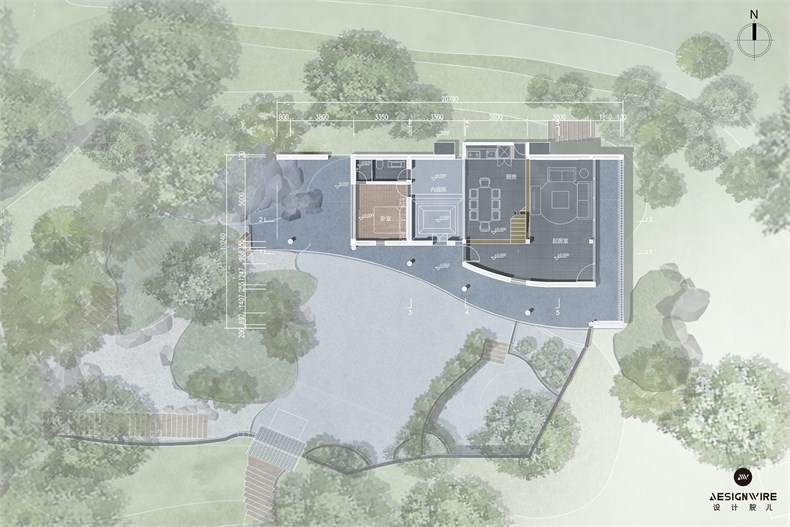
▲一层平面图 the first floor plan

▲二层平面图 the second floor plan
To build a two curved roofs in limited technical conditions, we "sliced" the wall in parallel to the mountain into a number of broken lines and started from the several structural curves in the direction of ridge. All the surfaces of the building were covered by a steel grid. The size of structural line along the ridge was enlarged to further indicate the twin roofs. In this structural system, the angles and positions of the curved surface of the roofs can be subtly adjusted and optimized in three dimensions using pixel wood batten craft on the surface.

▲立面图 elevations
基于钢结构的构架形式,原有墙体部分在建造过程中先由原墙体的老砖逐块标号保存,并待新基础及主体钢结构施工结束后原位复建。而复建砖墙的过程中,为了将钢结构掩藏于传统建造元素,许多老砖需要被切成薄片作为外贴饰面使用(这种方法多在当地修复和翻建传统民居时为节省老砖材料所采用)。新产生的墙体部分由当地其他建筑上的不同型号的老砖砌筑而成,为了进一步彰显且其差异,我们将新砌筑的部分刷上江南和徽州民居常见的白漆,并在两种砖体交接处进行了处理和做旧,使二者形成既和谐又统一的关系。整个建筑的立柱及屋面也均采用了其他老旧民居上回收的老料老瓦,并由当地工匠由本地传统工法砌筑而成;这样一方面在建构方式上回应了本土的文化性,另一方面也体现了可持续的生态理念。
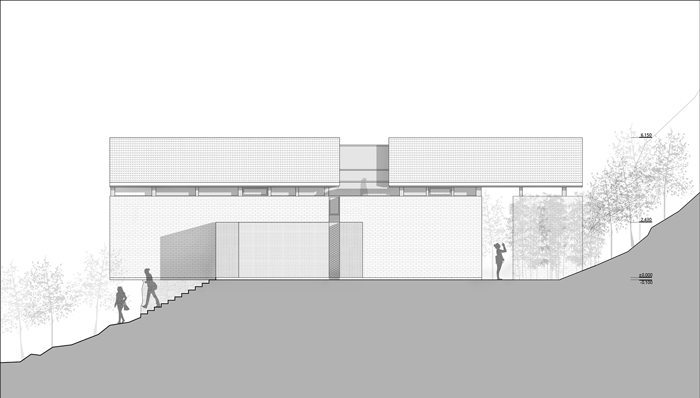
▲北南西立面图 elevations in north, south and west sides
Based on the structural form of steel structure, during construction the old bricks of the original wall were marked down with numbers and kept aside. After the new foundation and main steel structure had been completed, the marked old bricks were used to rebuild the original wall at the site. In the process of rebuilding the wall, many old bricks were cut into slices and used as traditional decoration for hiding the steel structure inside. (This method is common in order to save the materials of old bricks in the process of recovering and rebuilding the traditional houses) New wall was built by different types of old bricks from other local buildings. For further underlining the difference, we laid white paint which is common in the south of the lower reaches of the Yangtze River and Huizhou on new walls. At the junction of two kinds of bricks we did some treatment and restored as old for harmony and unification. Using old materials and old tiles collected from other old buildings, the columns and roof of the whole building were built by local craftsmen with local traditional techniques, In this way, we responded to the native culture and the vernacular sustainable concept.
建筑师/Architect: RSAA/庄子玉工作室/ RSAA/ Büro Ziyu Zhuang
主创建筑师/Principal Architect:庄子玉/ZHUANG Ziyu
设计团队/Design Team: 戚征东,李娜,李京,赵欣,范宏宇,朱坤宇,王佳欣(实习生)/QI Zhengdong,LI Na, LI Jing, ZHAO Xin, FAN Hongyu, ZHU Kunyu, WANG Jiaxin(Intern)
建筑顾问/Architecture Consultant: 吴彦祖/Daniel Wu
景观顾问/Landscape Consultant: 杨树根/YANG Shugen
灯光顾问/Lighting Consultant:张晨露/Chloe Zhang/GLD
施工团队/Construction Team:安徽江南文旅集团有限公司/ Anhui Jiangnan Cultural Tourism Group
业主单位/Owner Unit:北京聚思传媒广告有限公司/ Brain Media
建筑面积/Floor Area: 160m2
景观面积/Landscape Area: 600m2
摄影师/Photographer:苏圣亮/SU Shengliang,梵几/FNJI
Edit by Designwire

